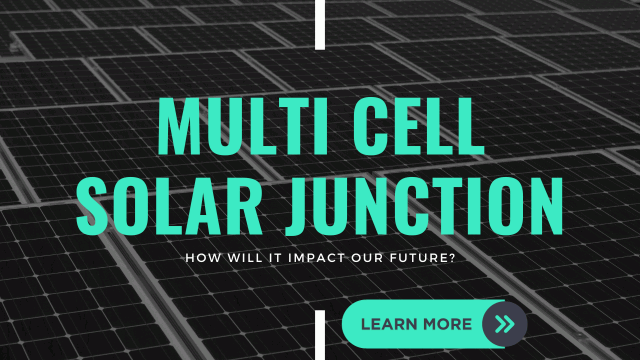What is Multi Cell Solar Junction?
Solar panel efficiency has been steadily improving over the years, and one of the innovations contributing to this progress is the development of multi-cell solar junctions.

These advanced solar cells are designed to absorb different wavelengths of sunlight by utilizing multiple layers of different semiconductor materials.
This unique construction allows multi cell solar junction to achieve higher efficiency in converting sunlight into electricity compared to traditional single-junction cells.
♦ The Basics of Solar Cells
To understand multi-cell solar junctions, it’s important to first grasp the fundamentals of solar cells. Traditional solar cells are typically made of silicon and consist of two layers: an n-type layer with a high concentration of electrons and a p-type layer with a relatively low concentration of electrons.
When sunlight strikes the n-type layer, electrons are excited and flow towards the p-type layer, creating an electrical current that can be harnessed for power. This single p-n junction is where the flow of electricity occurs in a single-junction solar cell.
♦ Introducing Multi Cell Solar Junction
Multi-cell solar junctions, also known as tandem solar cells, take the concept of a single p-n junction and expand it into multiple junctions.
These solar cells are made up of stacked layers of different semiconductor materials, each optimized to absorb specific frequencies of sunlight.
By utilizing multiple junctions, multi cell solar junction can capture and convert a broader range of sunlight, resulting in increased efficiency.

♦ How Multi Cell Solar Junction Work
The operation of multi-cell solar junctions is based on the same photovoltaic effect as single-junction cells. When sunlight hits the semiconductor layers of the multi-cell solar junction, photons with sufficient energy knock electrons loose from their atoms, creating electron-hole pairs.
These loose electrons then flow through the various p-n junctions, generating an electrical current. The current is collected and transferred through external wires for practical use.
♦ Efficiency of Multi-Cell Solar Junctions
The efficiency of a solar cell refers to the percentage of incoming sunlight that can be converted into usable electricity. Multi-cell solar junctions have the potential to achieve significantly higher efficiencies compared to single-junction cells.
The Department of Energy estimates that multi-cell solar junctions with three junctions can achieve theoretical efficiencies exceeding 45 percent, while single-junction cells typically top out at around 33.5 percent.
The addition of more junctions, potentially up to five or six, could further boost efficiency by over 70 percent.
♦ Materials Used in Multi Cell Solar Junction
Unlike single-junction solar cells, which predominantly use silicon, multi-cell solar junctions utilize a combination of different semiconductor materials.
Common materials include gallium indium phosphide (GaInP), indium gallium arsenide (InGaAs), and germanium (Ge). Each material is specifically chosen for its ability to respond to different wavelengths of sunlight, allowing for optimal absorption and conversion of solar energy.

♦ Challenges and Limitations of Multi Cell Solar Junction
While multi-cell solar junctions hold great promise for increasing the efficiency of solar panels, there are several challenges and limitations that need to be addressed.
Currently, high production costs and ongoing research and development make multi-cell solar junctions commercially unfeasible.
The complexity of manufacturing processes, the use of expensive materials, and the need for precise electrical matching between layers all contribute to the high costs associated with multi-cell solar junctions.
♦ Advantages of Multi Cell Solar Junction
Despite the challenges, multi-cell solar junctions offer several advantages over their single-junction counterparts. The increased efficiency of multi cell solar junction means that less surface area is required to generate the same amount of electricity, making them ideal for space-constrained installations.
Additionally, the ability to capture a wider range of wavelengths allows multi-cell solar junctions to perform well in low-light conditions, such as cloudy or overcast days.
♦ Disadvantages of Multi Cell Solar Junction
Alongside the advantages, there are also disadvantages to consider when it comes to multi-cell solar junctions. The high production costs make them less accessible for widespread adoption, limiting their current use to specialized applications.
The complex manufacturing processes and the need for precise electrical matching between layers also contribute to the challenges associated with implementing multi-cell solar junctions on a large scale.

♦ Future Prospects for Multi Cell Solar Junction
Despite the current limitations, ongoing research and development efforts are focused on overcoming the challenges associated with multi-cell solar junctions.
As manufacturing processes are refined and costs decrease, it is expected that the commercial viability of multi-cell solar junctions will improve.
Continued advancements in materials and design are also likely to further enhance the efficiency and performance of these solar cells.
Conclusion
Multi-cell solar junctions represent an exciting technology that has the potential to revolutionize solar panel efficiency. By utilizing multiple p-n junctions and different semiconductor materials, these solar cells can capture a broader range of sunlight and convert it into electricity more efficiently than single-junction cells.
While challenges and limitations exist, ongoing research and development efforts are focused on addressing these issues and making multi-cell solar junctions more commercially viable.
As the renewable energy industry continues to evolve, multi-cell solar junctions could play a significant role in achieving higher efficiency and increasing the adoption of solar power.
Frequently Asked Questions
1. How do multi-cell solar junctions differ from single-junction solar cells?
Multi-cell solar junctions have multiple p-n junctions, allowing them to absorb a wider range of sunlight wavelengths and achieve higher efficiency compared to single-junction cells.
2. What materials are used in multi cell solar junction?
Common materials used in multi-cell solar junctions include gallium indium phosphide (GaInP), indium gallium arsenide (InGaAs), and germanium (Ge). These materials are selected for their ability to respond to specific wavelengths of sunlight.
3. What is the efficiency of multi cell solar junction?
Multi-cell solar junctions have the potential to achieve theoretical efficiencies exceeding 45 percent, while single-junction cells typically top out at around 33.5 percent.
4. What are the advantages of multi cell solar junction?
Multi-cell solar junctions offer advantages such as increased efficiency, the ability to capture a wider range of wavelengths, and better performance in low-light conditions.
5. What are the challenges associated with multi cell solar junction?
The challenges include high production costs, complex manufacturing processes, and the need for precise electrical matching between layers. These factors limit the commercial feasibility of multi-cell solar junctions.
Call to Action
If you’re considering solar energy for your property, explore the range of high-efficiency solar panels available from reputable manufacturers.
While multi cell solar junction are still in the research and development phase, there are many options for high-performance solar panels that can effectively convert sunlight into clean and free electricity.
Visit the Energy-Sage Solar Marketplace to compare qualified local installers and find the best solar solution for your needs. Start harnessing the power of the sun today and contribute to a sustainable future.
Get access all prompts: https://bitly.com/xyz







